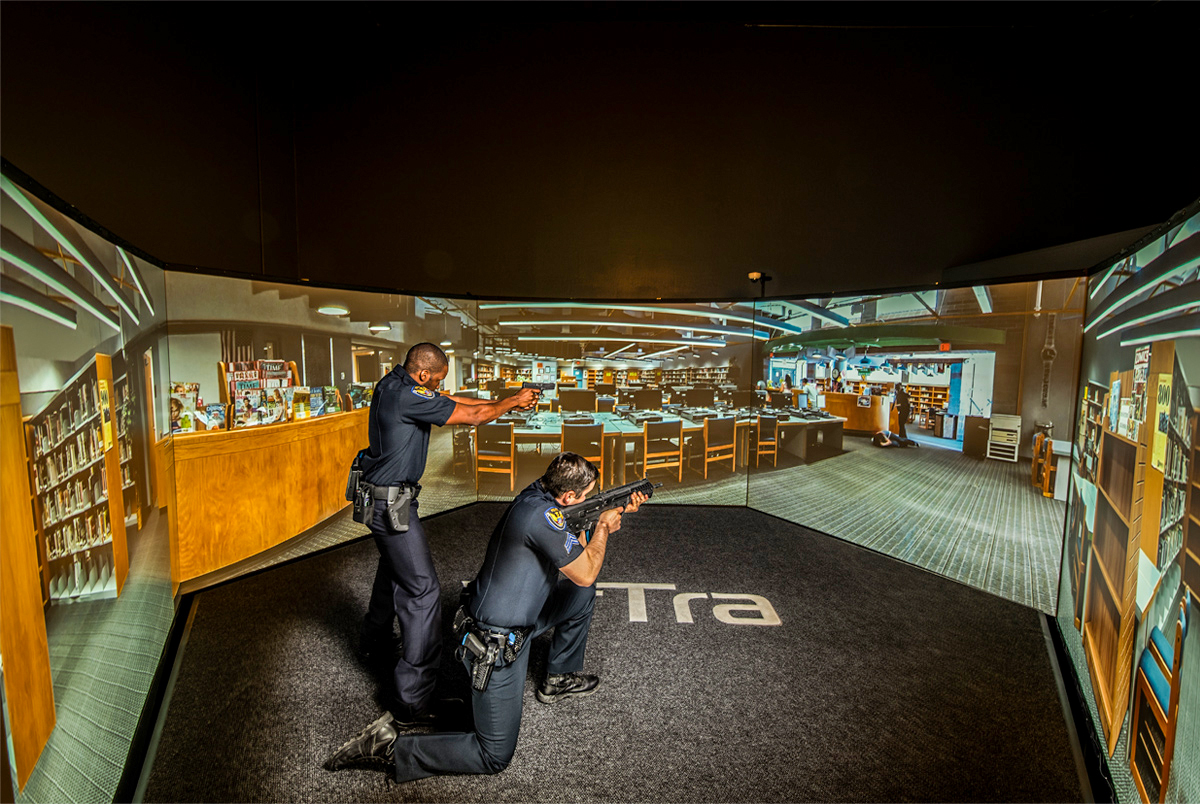
Multi-sensory training should be considered a non-negotiable for law enforcement agencies that expect their officers to perform in high-stakes moments.
Hesitation can cost lives. And the only way to eliminate hesitation completely is to take a realistic approach to your training.
Officers must read the room in an instant by hearing subtle sounds, feeling physical cues, and reacting without second-guessing.
But, most training environments fall short. They simply can’t replicate the chaos, pressure, and split-second demands of the field, leaving officers unprepared for the sensory overload of real incidents.
That’s why VirTra’s simulators are rooted in multi-sensory concepts. Simply put, they bring the field to the training room.
With immersive visuals, authentic audio, and realistic physical feedback, officers can sharpen instincts, build muscle memory, and make confident decisions … all without the risk of real-world consequences.
The Science Behind Multi-Sensory Learning
When the brain receives the same sensory input repeatedly, whether it’s visual, auditory, or tactile, it begins creating strong neural pathways. Everyone has heard of muscle memory. In the context of law enforcement officers, this means drawing on familiar sensory cues during high-pressure moments becomes second nature. The more often these cues are experienced in training, the quicker the brain can trigger the appropriate physical response, resulting in faster reaction times and more accurate decision-making in the field. Over time, these reinforced neural connections make essential skills nearly automatic, freeing up mental bandwidth for assessing evolving situations.
Multi-sensory learning also addresses cognitive load reduction—the ability to process and prioritize key information without being overwhelmed. In complex, multi-sensory environments, the brain is forced to filter out irrelevant stimuli and focus on mission-critical cues. Over time, this skill becomes ingrained, allowing officers to make rapid, informed decisions with less mental fatigue. By engaging multiple senses during training, instructors replicate the dynamic, unpredictable nature of real-world encounters while giving officers the tools to stay oriented, make sound judgments, and act decisively.
Breaking Down the Four Key Sensory Elements in VirTra Training
1. Realistic Audio
-
Ambient noise (traffic, sirens, crowd chatter) builds true situational awareness.
-
Directional audio trains officers to localize threats and identify potential dangers they can’t see.
2. Dialogue and Interactive Scenarios
-
Branching dialogue with on-screen characters for communication and de-escalation practice.
-
Dynamic suspect and bystander responses based on officer actions.
-
Builds verbal command skills and emotional control under tension.
3. High-Fidelity Visuals
-
4K ultra-realistic video scenarios capture body language, micro-expressions, and subtle threat indicators.
-
300° wraparound environments for peripheral vision training.
-
Multiple environmental conditions (night, rain, glare) for adaptability.
4. Physical Feedback (Haptics)
-
Recoil kits simulate firearm discharge for realistic weapon handling.
-
Belt zap or vibration replicates consequences of errors — creates urgency and reinforces accountability.
-
Improves stress response conditioning in a safe setting.
Agency Outcomes and Officer Testimonial
This article by WCLA News captures the impact VirTra’s products had on MORE than just one town or department.
Illinois recently unveiled a VirTra simulator at the Law Enforcement Training and Standards Board’s Springfield location, designed to give officers across the state realistic training experiences. The wraparound screens react to the officer’s actions with simulated weapons like guns, tasers, and pepper spray, allowing each scenario to change dynamically based on the officer’s decisions.
Here’s the cool part: Unlike many simulators limited to larger departments or academies, this simulator is accessible to any law enforcement agency in Illinois at no cost, helping bridge the training gap between big-city and small-town departments.
“I can’t understate the importance of this,” Chatham police officer Dave Leach told WCIA News. “I didn’t get this 20 years ago.”
The simulator was purchased to meet training requirements in the SAFE-T Act, which identified the need for more hands-on, scenario-based instruction. Officers have the ability to train during any stage of their careers, building skills from de-escalation to advanced tactics while safely experiencing the stress and unpredictability of real-life encounters.
“This virtual reality system will allow an officer to be immersed in a situation that is very real… heart rates go up, anxiety goes up, voices go up,” said Paul Petty, ILETSB’s Manager of In-Service Training. By providing a controlled yet lifelike environment, the simulator enables officers to learn from mistakes and improve decision-making without real consequences.
Contact Us Today
Reach out to our team! We’re excited to hear about your agency and get you started in the world of multi-sensory training. Together, we’ll discover which VirTra simulator best aligns with your department.







